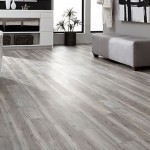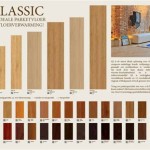Is Vinyl Plank Flooring Toxic To Humans? A Comprehensive Look at the Concerns
Vinyl plank flooring has become a popular choice for homeowners and businesses alike due to its durability, water resistance, ease of installation, and relatively low cost. However, concerns regarding its potential toxicity to humans have surfaced, prompting investigations into the materials used in its manufacturing process and the chemicals released during its lifespan.
The perception of vinyl plank flooring's toxicity stems primarily from the composition of the product itself. Traditional vinyl flooring, including vinyl plank, is made from polyvinyl chloride (PVC), a synthetic plastic polymer. The production and use of PVC have been linked to environmental and health concerns. Phthalates, historically utilized as plasticizers to enhance PVC's flexibility, have also been identified as potential endocrine disruptors. Volatile organic compounds (VOCs), released from various building materials, including vinyl flooring, can contribute to indoor air pollution and adverse health effects. Understanding these components and their potential impacts is crucial for evaluating the overall safety of vinyl plank flooring.
The Role of PVC and its Environmental Impact
Polyvinyl chloride (PVC) is the foundation of many vinyl plank flooring products. The creation of PVC involves the polymerization of vinyl chloride monomer (VCM). While modern manufacturing processes have significantly reduced VCM emissions, residual VCM can still be a concern. Furthermore, the production of VCM itself involves environmentally hazardous chemicals and energy-intensive processes, contributing to pollution and greenhouse gas emissions. The disposal of PVC products at the end of their life cycle presents another environmental challenge, as PVC is not readily biodegradable and can release harmful substances if incinerated improperly.
The environmental consequences associated with PVC production are not directly related to the toxicity of the finished vinyl plank flooring product to humans. However, these factors are an important part of the overall environmental impact. It is crucial to consider the entire life cycle of the product, from resource extraction and manufacturing to usage and disposal, to fully assess its sustainability and potential environmental harm.
Manufacturers are increasingly exploring alternatives to traditional PVC, such as bio-based polymers and recycled materials. These efforts aim to reduce the environmental footprint of vinyl flooring and mitigate the negative impacts associated with PVC production. Consumers interested in environmentally friendly options should look for certifications and labels indicating the use of sustainable materials and manufacturing processes.
Phthalates and Potential Health Concerns
Phthalates are a group of chemicals historically used as plasticizers in vinyl flooring to increase its flexibility and durability. However, certain phthalates have been identified as potential endocrine disruptors, meaning they can interfere with the body's hormonal system. Exposure to phthalates has been linked to adverse health effects, including reproductive and developmental issues, particularly in children and pregnant women. Due to these concerns, the use of certain phthalates has been restricted or banned in various consumer products, including children's toys and some types of flooring.
It's vital to differentiate between older and newer vinyl flooring products. Modern vinyl plank flooring is often manufactured without phthalates, or with phthalates that are considered safer for human health. Manufacturers have responded to consumer concerns and regulatory pressure by developing alternative plasticizers that are less likely to cause adverse health effects. Consumers should carefully examine product labels and specifications to ensure that the vinyl plank flooring they are considering is phthalate-free or uses safer alternatives.
While phthalates are a valid concern, it is also crucial to recognize that exposure to phthalates is ubiquitous in modern life. They are present in various products, including personal care items, food packaging, and medical devices. Therefore, assessing the contribution of vinyl flooring to overall phthalate exposure requires a comprehensive evaluation of all potential sources. Furthermore, the level of phthalates released from vinyl flooring tends to decrease over time, particularly in well-ventilated environments.
Volatile Organic Compounds (VOCs) and Indoor Air Quality
Volatile organic compounds (VOCs) are chemicals that evaporate at room temperature and can contribute to indoor air pollution. Vinyl plank flooring, like many other building materials and household products, can emit VOCs, particularly during and shortly after installation. These emissions can affect indoor air quality and potentially cause adverse health effects, such as eye, nose, and throat irritation, headaches, dizziness, and respiratory problems. Some VOCs are also classified as carcinogens or suspected carcinogens.
The type and amount of VOCs emitted from vinyl plank flooring can vary depending on the specific product, its manufacturing process, and the materials used. Flooring products that meet low-VOC standards, such as those certified by FloorScore or Greenguard, are designed to minimize VOC emissions and promote healthier indoor air quality. These certifications indicate that the product has been tested and meets stringent criteria for VOC emissions.
Several strategies can mitigate VOC emissions from vinyl plank flooring. Proper ventilation during and after installation is essential to allow VOCs to dissipate. Allowing the flooring to acclimate in a well-ventilated area before installation can also help reduce initial emissions. Choosing low-VOC adhesives and sealants for installation is another important step. Furthermore, maintaining good indoor air quality through regular ventilation and air filtration can help minimize the potential health effects of VOCs.
The perception of vinyl plank flooring as toxic often hinges on the concern about VOCs. However, the actual risk depends on various factors, including the type and concentration of VOCs emitted, the duration and level of exposure, and individual sensitivity. While some individuals may experience adverse health effects from VOC exposure, others may not be affected. Selecting low-VOC flooring products and implementing strategies to improve indoor air quality can significantly reduce the potential risks.
Beyond the specific components already discussed, it's important to note the potential for off-gassing of other chemicals during the lifespan of vinyl plank flooring. These may include stabilizers, pigments, and flame retardants, albeit the flame retardants are more common in commercial products. The concentration of these chemicals released is typically low and decreases over time, but individuals with heightened sensitivities or allergies may experience reactions. Regular cleaning can help maintain the surface integrity of the flooring and minimize potential off-gassing.
The type of adhesive used for installation can also contribute to potential toxicity. Certain adhesives may contain VOCs or other harmful chemicals. Choosing low-VOC or zero-VOC adhesives is essential to minimize indoor air pollution. Solvent-free adhesives are also a safer alternative to solvent-based adhesives.
The health impacts of vinyl plank flooring are not uniform across all individuals. People with pre-existing respiratory conditions, allergies, or chemical sensitivities may be more susceptible to adverse effects from VOCs or other chemicals released from the flooring. Children and pregnant women may also be at higher risk due to their developing bodies and increased vulnerability to environmental toxins. It is crucial to consider individual health factors when selecting flooring materials and to take steps to minimize potential exposures.
The manufacturing process for vinyl plank flooring can also influence its potential toxicity. Manufacturers that prioritize sustainable practices and utilize advanced technologies to minimize emissions and waste can produce flooring products that are safer for human health and the environment. Consumers should seek out manufacturers with transparent environmental policies and certifications that demonstrate a commitment to sustainability.
The maintenance and cleaning of vinyl plank flooring can also affect its durability and potential for releasing chemicals. Harsh cleaning products containing strong solvents or abrasive agents can damage the flooring's surface and increase the likelihood of VOC emissions. Using gentle, pH-neutral cleaners and following the manufacturer's instructions for cleaning can help preserve the flooring's integrity and minimize potential health risks.
The overall safety of vinyl plank flooring is a complex issue with no definitive answer. The potential for toxicity depends on various factors, including the product's composition, manufacturing process, installation practices, and maintenance routines. While some types of vinyl plank flooring may pose a greater risk than others, the availability of low-VOC and phthalate-free options allows consumers to make informed choices that prioritize their health and the environment.

The Dangers Of Luxury Vinyl Floors Lvt And How You Can Avoid Them Artisan Wood Llc

Are Vinyl Floors Toxic Olde Tyme Floor

Is Vinyl Flooring Harmful To Health Singapore Laminate

The Dangers Of Luxury Vinyl Floors Lvt And How You Can Avoid Them Artisan Wood Llc

Are Vinyl Floors Toxic Olde Tyme Floor
Is Lvp Flooring Toxic Here What Our Expert Says

Is Vinyl Floor Considered Toxic By Timber Flooring Specialists Installation

The Dangers Of Vinyl Plank Flooring Auten Wideplank

Is Vinyl Flooring Toxic A Detailed Investigation My Chemical Free House

Is Luxury Vinyl Flooring Toxic Health Risks
Related Posts








